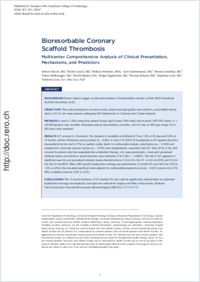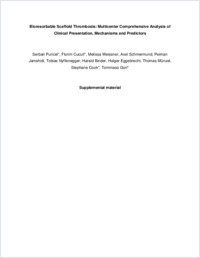Bioresorbable coronary scaffold thrombosis: multicenter comprehensive analysis of clinical presentation, mechanisms, and predictors
- Puricel, Serban Department of Cardiology, University of Fribourg & Hospital Fribourg, Switzerland
- Cuculi, Florim Department of Cardiology, Luzerner Kantonsspital, Luzern, Switzerland
- Weissner, Melissa Zentrum für Kardiologie, University Hospital Mainz, Mainz, Germany, and German Center for Cardiac and Vascular Research (DZHK), Standort Rhein-Main, Germany
- Schmermun, Axel Cardioangiologisches Centrum Bethanien, Frankfurt am Main, Germany
- Jamshidi, Peiman Department of Cardiology, Luzerner Kantonsspital, Luzern, Switzerland
- Nyffenegger, Tobias Department of Cardiology, Luzerner Kantonsspital, Luzern, Switzerland
- Binder, Harald Institute of Medical Biostatistics, Epidemiology and Informatics, University Hospital Mainz, Germany
- Eggebrecht, Holger Cardioangiologisches Centrum Bethanien, Frankfurt am Main, Germany
- Münzel, Thomas Zentrum für Kardiologie, University Hospital Mainz, Mainz, Germany, and German Center for Cardiac and Vascular Research (DZHK), Standort Rhein-Main, Germany
- Cook, Stéphane Department of Cardiology, University of Fribourg & Hospital Fribourg, Switzerland
- Gori, Tommaso Zentrum für Kardiologie, University Hospital Mainz, Mainz, Germany, and German Center for Cardiac and Vascular Research (DZHK), Standort Rhein-Main, Germany
-
01.03.2016
Published in:
- Journal of the American College of Cardiology. - 2016, vol. 67, no. 8, p. 921–931
English
Background Recent reports suggest an elevated incidence of bioresorbable vascular scaffold (BVS) thrombosis (scaffold thrombosis [ScT]).Objectives This study investigated occurrence rates, clinical and angiographic characteristics, and possible mechanisms of ScT in all-comer patients undergoing BVS implantation at 2 German and 2 Swiss hospitals.Methods A total of 1,305 consecutive patients (mean age 64 years, 78% male) who received 1,870 BVS (mean 1.4 ± 0.8 BVS/patient) were enrolled. Clinical/procedural characteristics, mortality, and ScT data at 485 days (range 312 to 652 days) were examined.Results ScT occurred in 42 patients. The incidence of probable and definite ScT was 1.8% at 30 days and 3.0% at 12 months, without differences among centers (p = 0.60). A total of 22 (52%) ScTs presented as ST-segment elevation myocardial infarction and 6 (17%) as sudden cardiac death. In multivariable analysis, ostial lesions (p = 0.049) and impaired left ventricular ejection fraction (p = 0.019) were independently associated with ScT. Nine (21%) of the ScTs occurred in patients who had suspended dual antiplatelet therapy, in 6 cases prematurely. Lower post-procedural minimum lumen and reference vessel diameters were hallmarks of ScT (all p < 0.0001). The risk of ScT appeared to rapidly increase for post-procedural minimum lumen diameters below 2.4 mm (for the 2.5- to 3.0-mm BVS) and 2.8 mm (for the 3.5-mm BVS). When a BVS-specific implantation strategy was implemented, 12-month ScT rates fell from 3.3% to 1.0%, an effect that remained significant when adjusted for multivariable propensity score (p = 0.012; hazard ratio: 0.19; 95% confidence interval: 0.05 to 0.70).Conclusions The 12-month incidence of ScT reached 3% and could be significantly reduced when an optimized implantation strategy was employed. (retrospective multicentric registry and Mainz Intracoronary Database. The Coronary Slow-flow and Microvascular Diseases Registry [MICAT]; NCT02180178)
- Faculty
- Faculté des sciences et de médecine
- Department
- Médecine 3ème année
- Language
-
- English
- Classification
- Pathology, clinical medicine
- License
-
License undefined
- Identifiers
-
- RERO DOC 258952
- DOI 10.1016/j.jacc.2015.12.019
- Persistent URL
- https://folia.unifr.ch/unifr/documents/304686
Other files
Statistics
Document views: 90
File downloads:
- pdf: 277
- Supplementary material: 120

